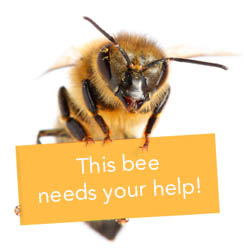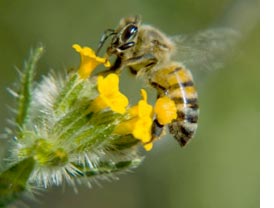What’s Killing the Bees?
- By Eileen Ecklund
- Reading Time: 5 mins.
 Beekeepers Report Huge Losses Over Winter
Beekeepers Report Huge Losses Over Winter
By Eileen Ecklund
Spring is in the air. Across the country, trees and other plants are bursting into flower, and bees are busy pollinating them. But this year the buzzing may seem a bit muted: fewer honeybees than ever made it through the winter, in a disappointing resurgence of the mysterious disease known as colony collapse disorder (CCD).
“The winter of 2013 is expected to be the worst we’ve seen since we’ve been monitoring,” Jeff Pettis, leader of the U.S. Department of Agriculture’s (USDA) Bee Research Laboratory, told The FruitGuys. The official results of an annual survey of losses in managed bee colonies, conducted by the Bee Informed Partnership, the USDA, and the Apiary Inspectors of America, won’t be out till early May, but “I’m confident that the losses will be over 40 percent this year,” Pettis said. “That’s a lot of bees.” In most of the surveys conducted since 2006, when CCD appeared on the scene, average losses have been 30-33 percent, while last year the average dropped to 22 percent.
Tim Tucker, vice president of the American Beekeeping Federation, puts this winter’s losses at between 40 and 50 percent. “This has been a tough winter for a lot of us beekeepers,” Tucker told The FruitGuys.
“Beekeepers are really suffering,” Pettis agreed, adding that there’s some concern about the availability of bees for crop pollination this year because of the heavy losses. Fewer bees may translate to higher costs to farmers, less productivity in the fields and orchards, and, ultimately, higher food prices for some crops that rely heavily on commercial pollination services. Earlier this year there were reports of bee shortages from California’s almond orchards, which typically require the services of more than half the nation’s commercial hives each February and March.
Want fruit for your office?
Get your office a free sample TODAY!Bees Under Stress
Bees that provide commercial pollination services can have intense schedules, Tucker said, going from almond orchards in California to the Northeast for blueberries and cranberries, or to Oregon and Washington for seed pollination of onions and alfalfa. Over the course of a season, bees may be trucked all over the country—one of the many, many stressors the tiny insects currently face. Others include new viruses and parasites, the changing climate, exposure to pesticides, and the loss of forage because so many farm fields have been converted to non-agricultural uses or are growing single crops (bees need a variety of food sources).
 The current thinking among bee researchers and other experts is that some combination of this multitude of ills likely causes CCD. “The common wisdom is that bees have gotten to the point of so much stress that their fitness is lowered and they get sick,” Scott Hoffman Black, executive director of the Xerces Society for Invertebrate Conservation, a nonprofit focused on wildlife protection, told The FruitGuys. “I think there is no ‘smoking gun’ yet.”
The current thinking among bee researchers and other experts is that some combination of this multitude of ills likely causes CCD. “The common wisdom is that bees have gotten to the point of so much stress that their fitness is lowered and they get sick,” Scott Hoffman Black, executive director of the Xerces Society for Invertebrate Conservation, a nonprofit focused on wildlife protection, told The FruitGuys. “I think there is no ‘smoking gun’ yet.”
That said, Black and others believe that one of the biggest contributing factors to poor bee health may be pesticides—in particular, a newer class of insecticides called neonicotinoids. The evidence is mounting, Black said, that the widespread use of neonicotinoids is harming bees.
Persistent Poisons
Many bees are killed outright by pesticide poisoning, often due to poor spraying practices. When it comes to CCD, however, beekeepers and environmentalists are more worried about the long-term effects of repeated exposure to lower levels of pesticides that, like the neonicotinoids, remain in the environment for a long time.
Neonicotinoids can persist in soil for months or years after a single application, and measurable amounts of residues were found in woody plants up to six years after a single application, Black said. “We’re just building these chemicals up in the environment.”
Neonicotinoids expose bees to toxins in a new way, Pettis said, because they’re systemic—meaning they’re absorbed by the plant so that the plant itself becomes the toxin—including the pollen that the bees transport back to their hives. While the levels that have been found in hives are “sub-lethal,” some bee advocates think they may be weakening the bees’ immune systems or making them more vulnerable to mites or other pests. Some studies have indicated that exposure to neonicotinoids can impair honeybees’ ability to fly and forage for food.
In March 2013, a group of four beekeepers and five environmental and consumer organizations filed suit against the Environmental Protection Agency (EPA) for failing to ban the use of two widely used neonicotinoids, clothianidin and thiamethoxam. The EPA is currently re-evaluating the pesticides but doesn’t expect to finish its review for several years, and has refused to ban them in the interim.
“The EPA is moving in small steps in the right direction, but I think we need to move faster and take bigger steps — this is a big, big problem,” Black said. In a congressional briefing on the impacts of pesticides on pollinators on March 19, Black called on the EPA to speed up the review process and suspend conditional registrations of products containing neonicotinoids until their effects are better understood.
“We approve these pesticides at the speed of light,” Black told The FruitGuys, “and then if there’s a problem, we re-review them at a glacial pace. Something’s wrong with the way the whole system is set up.”
In the meantime, beekeepers, environmentalists, and concerned citizens will just have to step up their efforts to help the tiny pollinators survive in an increasingly hostile environment.
Want farm-fresh fruit?
We've got you covered.Resources: How to Help Bees
- Plant for PollinatorsӬ
Choose native plants for your garden that provide forage for pollinators. BeeSmart is a handy iPhone/Android app that lists region-specific pollinator-friendly plants.
If you want to learn more or get involved, here are a few organizations to get you started:
- National Pollinator Defense Fund: Dedicated to protecting managed and native pollinators from harm caused by pesticides. Provides legal support and other guidance to beekeepers; works to ensure proper regulation and enforcement of pesticide use.
- Pesticide Action Network: Promotes alternatives to pesticides; one of the plaintiffs in the recently filed lawsuit against neonicotinoids.
- Pollinator Partnership: Helps protect and promote all pollinators through conservation, education, and research. Publishes a series of free pollinator-friendly planting guides by eco region and manages the North American Pollinator Protection Campaign.
- The Xerces Society for Invertebrate Conservation: Dedicated to preserving invertebrates and their habitat worldwide. Very active in pollinator conservation and an excellent resource for information about pollinators and pollinator-friendly practices.
Want farm-fresh fruit?
We've got you covered.
______________
Eileen Ecklund is a San Francisco-based writer and editor.


